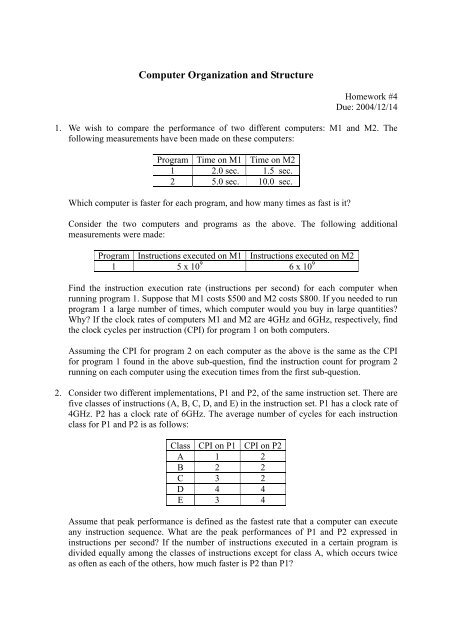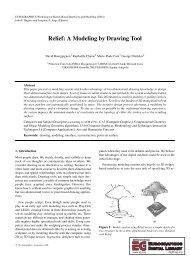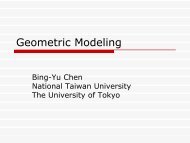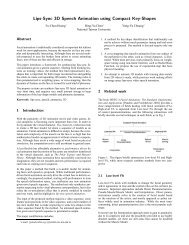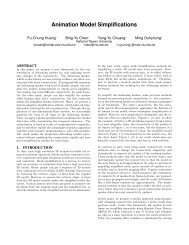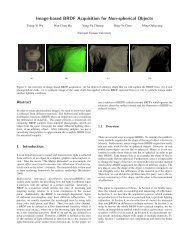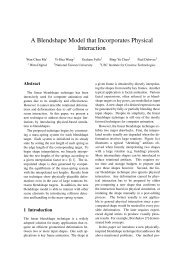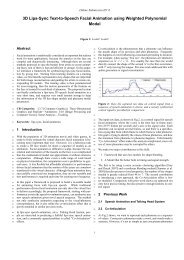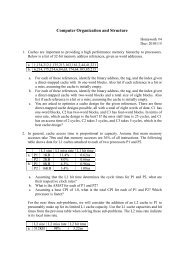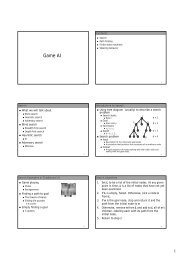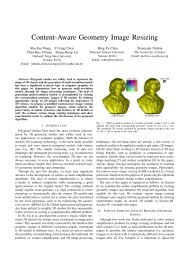Computer Organization and Structure - Computer Graphics Laboratory
Computer Organization and Structure - Computer Graphics Laboratory
Computer Organization and Structure - Computer Graphics Laboratory
You also want an ePaper? Increase the reach of your titles
YUMPU automatically turns print PDFs into web optimized ePapers that Google loves.
<strong>Computer</strong> <strong>Organization</strong> <strong>and</strong> <strong>Structure</strong>Homework #4Due: 2004/12/141. We wish to compare the performance of two different computers: M1 <strong>and</strong> M2. Thefollowing measurements have been made on these computers:Program Time on M1 Time on M21 2.0 sec. 1.5 sec.2 5.0 sec. 10.0 sec.Which computer is faster for each program, <strong>and</strong> how many times as fast is it?Consider the two computers <strong>and</strong> programs as the above. The following additionalmeasurements were made:Program Instructions executed on M1 Instructions executed on M21 5 x 10 9 6 x 10 9Find the instruction execution rate (instructions per second) for each computer whenrunning program 1. Suppose that M1 costs $500 <strong>and</strong> M2 costs $800. If you needed to runprogram 1 a large number of times, which computer would you buy in large quantities?Why? If the clock rates of computers M1 <strong>and</strong> M2 are 4GHz <strong>and</strong> 6GHz, respectively, findthe clock cycles per instruction (CPI) for program 1 on both computers.Assuming the CPI for program 2 on each computer as the above is the same as the CPIfor program 1 found in the above sub-question, find the instruction count for program 2running on each computer using the execution times from the first sub-question.2. Consider two different implementations, P1 <strong>and</strong> P2, of the same instruction set. There arefive classes of instructions (A, B, C, D, <strong>and</strong> E) in the instruction set. P1 has a clock rate of4GHz. P2 has a clock rate of 6GHz. The average number of cycles for each instructionclass for P1 <strong>and</strong> P2 is as follows:Class CPI on P1 CPI on P2A 1 2B 2 2C 3 2D 4 4E 3 4Assume that peak performance is defined as the fastest rate that a computer can executeany instruction sequence. What are the peak performances of P1 <strong>and</strong> P2 expressed ininstructions per second? If the number of instructions executed in a certain program isdivided equally among the classes of instructions except for class A, which occurs twiceas often as each of the others, how much faster is P2 than P1?
3. We wish to add the instructions addi (add immediate), jr (jump register), sll (shiftleft logical), <strong>and</strong> lui (load upper immediate) to the single-cycle datapath. Add anynecessary datapaths <strong>and</strong> control signals to Figure 1 <strong>and</strong> show the necessary additions toTable 1. You can photocopy Figure 1 <strong>and</strong> Table 1 to make it faster to show the additions.Figure 1: The simple datapath with the control unit.MemtoInstruction RegDst ALUSrc RegRegWriteMemReadMemWrite Branch ALUOp1 ALUOp0R-format 1 0 0 1 0 0 0 1 0lw 0 1 1 1 1 0 0 0 0sw X 1 X 0 0 1 0 0 0beq X 0 X 0 0 0 1 0 1Table 1: The setting of the control lines is completely determined by the opcode fields ofthe instruction.4. We wish to add the instructions lui (load upper immediate) <strong>and</strong> ldi (load immediate)to the multicycle datapath, respectively. The ldi instruction loads a 32-bit immediatevalue from the memory location following the instruction address. Use the same structureof the multicycle datapath of Figure 2 <strong>and</strong> show the necessary modifications to the finitestate machine of Figure 3. How many cycles are required to implement this instruction?
Figure 2: The complete datapath for the multicycle implementation together with thenecessary control lines.Figure 3: The complete finite state machine control for the datapath shown in Figure 2.
5. In estimating the performance of the single-cycle implementation, we assumed that onlythe major functional units had any delay (i.e., the delay of the multiplexors, control unit,PC access, sign extension unit, <strong>and</strong> wires was considered to be negligible). Assume thatwe use a different type of adder for simple addition:Memory units: 200psALU: 200psadder for PC + 4: Xpsadder for branch address computation: YpsRegister file (read or write): 100psa. What would the cycle time be if X=300 <strong>and</strong> Y=300?b. What would the cycle time be if X=500 <strong>and</strong> Y=500?c. What would the cycle time be if X=100 <strong>and</strong> Y=800?


